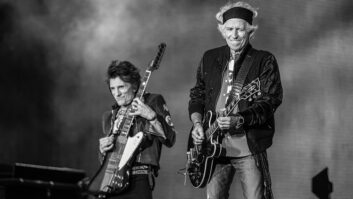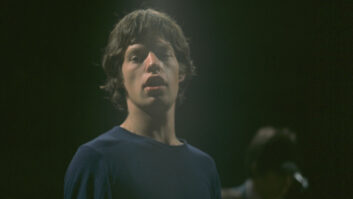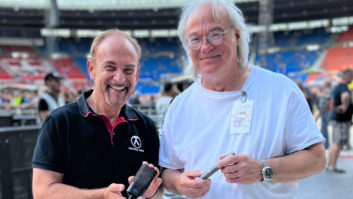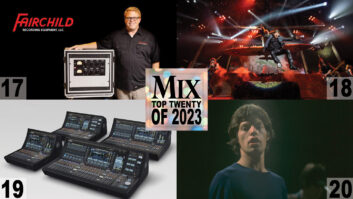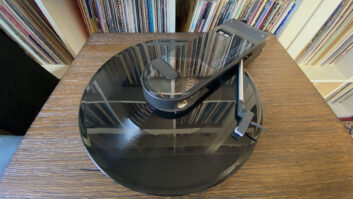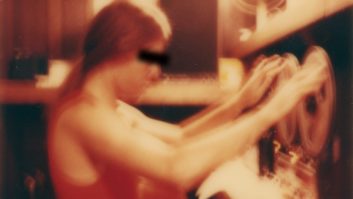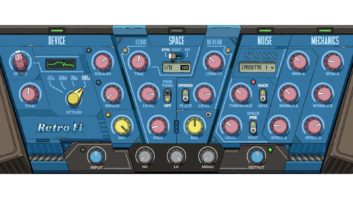
After 24 years on hiatus, The Cars hit the road this spring in support of their new album, Move Like This. The band has always had a knack with ear-candy, crafting three-minute pop songs filled with sweet hooks, tangy quirks and crunchy rock, all wrapped up in sleek production; helping the group achieve that studio-like sheen on tour was veteran FOH engineer Tim “Quake” Mark.
The production carried gear from Pro Media/Ultrasound (Hercules, CA) for the FOH and monitor positions, picking up local stacks and racks at every stop, including New York City’s Roseland Ballroom, where the system in question was a sizable Crown-powered JBL VerTec rig from RSA Audio (Edgewood, NY).
As is the case with any act returning to the spotlight, there were inevitable changes, the most obvious being the absence of co-singer/bassist Benjamin Orr, who died of cancer in 2000. Rather than attempt to replace him, leader Ric Ocasek took over all lead vocals while multi-instrumentalist Greg Hawkes played bass lines on keyboards and occasionally one of Orr’s basses.
Despite having four musicians on stage, there were only nine open mics—four on guitars and five for vocals. “Many of the vocals stay muted when I’m not using them,” said Quake, “because this is an old-school band that plays through 100-watt Marshalls—not a problem, I can deal with that—and the drums are all electronic. It’s funny though; everybody’s like, ‘Wow, it’s got to be great only having nine mics.’ Well, there’s still a lot of mixing going on; it’s not just ‘set and forget.’ I have snapshots for every single song because there are so many different changes to the effects throughout the night. They play 19 songs, and I’ve got 29 cues for the show.”
All that mixing took place on an Avid Venue Profile desk, loaded to the brim with Quake’s favorite plugins to help re-create some studio polish. “That huge production is what people are expecting to hear,” he admitted. “It’s actually been quite the challenge to recreate, because they were produced by Roy Thomas Baker when they started out, so there were 800 vocal tracks going on, layered delays, the works.
“To reproduce that here, I stick to a pretty basic package using a couple of different D-Verb reverbs, and Smack on vocals. I’ve also got the Line 6 Echo Farm plug, set on the Maestro Pedal; I’m using that primarily because on those records, there’s a few tracks where they do ping-pong delays bouncing all over the place. I use the Eventide Octavox, which is the closest thing I could find to an old Yamaha SPXtype harmonizer; truthfully, it’s a little bit of overkill, because I don’t really need as much control as I have here. There’s also the Voce Chorus/ Vibrato, which makes it as if you’re running the vocal through a Leslie cabinet, which helps [create] that slap back.
“Some plug-ins are just for specific songs, like ‘Moving In Stereo’— which immediately makes me think of Fast Times at Ridgemont High and Phoebe Cates coming out of the pool. I’ve got three or four snapshots during that song, changing the effects to keep up with them. I use the Waves MetaFlanger on the last part to re-create that megaphone sound that he’s got, and it’s also the flanger I use for left and right.”

Miking the stage were typical Shure 58s for vocals, while guitarist Elliot Easton’s joyful leads came out of Marshall cabinets to be captured via an Audix CX-112 and a Shure 57. Meanwhile Ocasek’s rhythm guitar was heard via the same mics applied a different way. “Using two mics [on each guitarist] gives me a little bit of a different texture on each side, so you get just a slight different flavor and it helps with the stereo imaging in the PA,” said Quake. “I wound up placing a 112 on Ric’s Ampeg setup because it’s a little bit brighter and the Ampeg tends to be a little bit duller, cleaner sound, whereas there’s a 57 on his Mesa Boogie because that’s just a straightout rock sound for him.”
Taking bass emulation to its logical extreme, Hawkes’ keyboardcreated bass lines and the bass guitar both ran through the bass amp onstage to help keep a consistent sound, localize the bass coming off the stage for the audience in front, and simplify the switch between synth and real bass. A Bomb Factory BF76 plug-in emulating a Universal Audio 1176 compressor was clamped down on the bass, and likewise on the Profile’s left and right outputs. Quake explained, “That way, I can squish it a little bit and get that Roy Thomas Baker, very tight mix thing going. I like to start to push into it a bit, and just pull the peaks off.”
Over at stageside, monitor engineer Tom Lyon oversaw an Avid Venue D-Show desk; since the band eschewed personal monitors, mixes were sent into one Meyer Sound MJF-212 floor monitor per player, along with 700-HP subs and MSL-4 sidefills, except for drummer David Robinson. Wearing headphones while playing his Roland V-Drums through Radial DIs, Robinson had his mix sent to a TD-20 percussion sound module and then on to an Avid Venue PQ personal monitor mix controller so he could control the levels of his drums, mix and an occasional click track. While he was playing V-Drums, Robinson nonetheless had a Plexiglas screen set up around him—not to restrain the acoustics of his electronic kit, which, of course, would be a mere tap, but rather to lessen the impact of Easton’s Marshall amps, which sat just 5 feet away from the drum throne.
For the Roseland gig, RSA Audio tech Mike Murphy looked after 16 JBL VerTec VT4889s, along with proprietary subs, front- and out-fills, all powered by Crown XTi 4000 amplifiers. The JBL boxes suited Quake fine, as he noted, “Al, our production manager, says this is a VerTec band, and I kind of get what he’s saying, because it has that chunky, rock sound to it. I’ve mixed the band on d&b rigs, Meyer Sound Milos, an old EV X-Array in Chicago and Clair i-3s up in Toronto. We’ve seen a little bit of everything, and this PA fits what the band’s doing right now, so it was nice to hear that RSA was available to do the show.”
Running only 10 sold-out shows in total, the coast-to-coast tour finished up right around the point where most productions start to finalize things. As if to underline that fact, Quake spent part of line check at Roseland (show number nine) tweaking the flange at the start of “You’re All I’ve Got Tonight.”

“They started playing it about a week ago,” he recalled. “They broke into it during soundcheck at First Avenue in Minneapolis, and I was like, ‘Wait, whoa, give me a second.’ Ric asked ‘What are you doing?’ I said I could do the flange and he broke into a huge grin. So they started up again, I hit it and he’s like, ‘Perfect.’”
Pro Media/Ultrasound
promediausa.com
VITALSTATS
The Cars
Pro Media / Ultrasound
(Hercules, CA)
FOH Engineer:
Tim “Quake” Mark
Monitor Engineer:
Tom Lyon
FOH Console:
Avid Venue Profile
Monitor Console:
Avid Venue D-Show
Monitor Speakers:
Meyer MJF-212, 700-HP, MSL-4
FOH Plug-Ins:
D-Verb, Smack; Line 6 Echo Farm; Eventide Octavox; Voce Chorus/ Vibrato; Waves MetaFlanger
Microphones:
Shure 58, 57; Audix CX-112; Radial DIs; Countryman DIs
